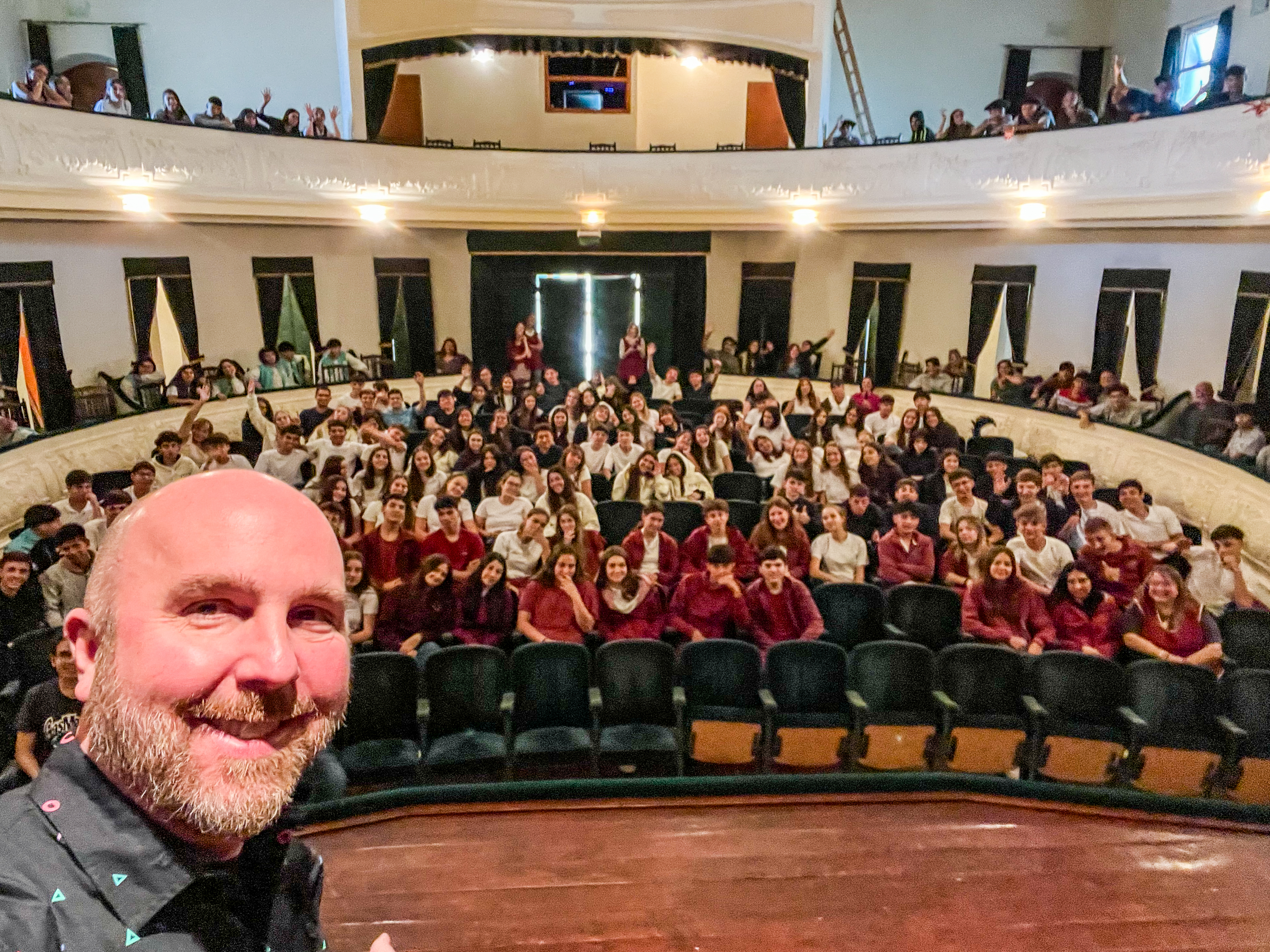
 John Moravec
John MoravecTeachers at the crossroads
We ask teachers to prepare students for an unpredictable, AI-infused, climate-volatile world. Yet we treat those same educators as if their job is to execute instructions, not invent solutions.
This what happens in a system designed to replicate itself.
But a good education does not happen without interpretation. It is a deeply contextual, improvisational, and relational act. If we want young people to learn how to collaborate, adapt, and think critically, then their teachers must be empowered to model those capacities. Teaching must be understood as intellectual work that is complex, creative, and consequential. From Manifesto 25:
Educators are creators, collaborators, and innovators, not cogs in a machine. Reducing them to implementers of legacy methods undermines both learners and the future of education. To address the demands of a dynamic, interconnected world, educators must be valued as individuals with unique needs, aspirations, and creative potential. Transforming education means enabling educators as co-creators, equipping them with trust, tools, and resources to drive innovation. Recognizing educators as professionals and partners fosters thriving learning environments where both teachers and students flourish, inspiring curiosity, adaptability, and resilience.
Life in the machine
Over the past four decades, waves of neoliberal reform have recast teachers as implementers of external mandates (that is, deliverers of content rather than designers). In the name of “accountability,” policymakers have introduced scripted curricula, high-stakes testing, and performance management tools designed to measure fidelity, not imagination. As Stephen Ball (2003) observes, this regime of managerialism transforms educators into policy delivery mechanisms, alienated from their own work. Michael Apple (2004) goes further, arguing that this technocratic turn strips teachers of professional autonomy and serves a political agenda of depoliticized, market-aligned schooling.
The symptoms are everywhere:
- Curriculum narrowing that rewards testable content over deep learning.
- Real-time surveillance via learning management systems and AI tools that quantify every click and keystroke.
- Evaluation frameworks that reduce complex pedagogical work to rubrics and checklists.
- Burnout and attrition driven by demoralization and from the erosion of purpose (Santoro, 2011).
This is bad for learning. When educators are denied space to exercise professional judgment, creativity disappears from the classroom. Risk-taking evaporates. Students learn to perform, not to inquire. The result? A profession in crisis. A pipeline problem not because people don’t want to teach, but because they no longer recognize the work as professional. The joy of teaching (i.e., designing experiences, supporting discovery, responding to the needs of real learners) is slowly being automated, outsourced, or erased.
Yet research consistently shows that teacher agency matters as equally for educator wellbeing as it is for student outcomes. Teachers who feel trusted, valued, and empowered are more likely to innovate, connect meaningfully with students, and stay in the profession. Agency is critical to both the construction of effective learning environments and the professional identity of educators.
We cannot build adaptive, equitable education systems on a foundation of teacher compliance. We need educators who can think, question, and create. But to get there, we must first identify (and dismantle) the systems that have constrained them.
Educators as designers
If we want education to be adaptive, relational, and future-focused, we must stop treating teachers like factory line workers. The work of teaching is centered on designing experiences and crafting spaces where inquiry can thrive, knowledge can evolve, and learners can take intellectual risks.
Pedagogical design requires much more than curriculum implementation. It demands interpretation, creativity, and responsiveness to context. Teachers are constantly making decisions: how to frame a question, when to push for precision, when to pause for care. These are intellectual, knowledge-based judgments that go beyond simple task completion.
Shifting the paradigm from delivery to design requires recognizing teachers as knowledge workers, not as cogs in a machine or compliance officers. As Pantić and Florian (2015) argue, teacher agency is a core driver of meaningful innovation. When educators are empowered to co-create curriculum, adapt pedagogy, and invent new learning ecologies, students receive a much richer experience.
Consider not the usual examples of project-based learning or inquiry units, but the boundary-pushers:
- Underground curriculum hacking, where teachers subvert prescribed content to include banned books, local histories, or queer epistemologies.
- Speculative education design, where educators collaborate with students to imagine future schools, rethinking everything from schedules to assessments to the role of AI.
- Teaching as social practice, where classrooms become organizing hubs, designing campaigns, building solidarity, or prototyping mutual aid structures.
This is design work rooted in purpose, and it is not limited to the privileged few. From Nairobi to Naples, educators are reimagining their roles not because the system asked them to, but because the system didn’t. Networks such as Rethinking Schools, Human Restoration Project, and teacher-activist collectives across underserved communities model a counter-professionalism that is insurgent, reflective, and unapologetically creative.
But innovation without infrastructure collapses. To support educators as designers, systems must shift from surveillance to support. This requires:
- Autonomy: the professional freedom to shape pedagogy without fear of reprisal.
- Time: to plan, collaborate, iterate, and recover.
- Trust: not earned through compliance, but extended as a condition of professional respect.
If we want students to learn creativity, collaboration, and critical thinking, we must invest in the people best positioned to model and teach those skills. Teachers don’t just need permission to innovate. They need systems that expect it and are prepared to follow their lead.
Innovation requires trust and infrastructure
Innovation in education does not begin with technology. It begins with trust.
When policymakers call for “transformation,” they often focus on visible, easy to manage tools such as digital platforms, new metrics, slick dashboards. They promise to create meaningful, positive changes, but change rarely happens. Authentic transformation happens at the level of relationships, time, and culture. You cannot automate inspiration. And you cannot systematize innovation by stripping educators of the very conditions that make it possible.
At its core, educational innovation requires three components:
- Professional autonomy: Teachers need room to interpret, design, and deviate from scripts that don’t serve their learners.
- Collaborative time: Not for compliance meetings, but for shared inquiry, dreaming, prototyping, and reflection.
- Cultures of trust: Where risk-taking is safe, dissent is welcomed, and learning is mutual between teachers, students, leaders, and communities.
Hargreaves and Fullan (2012) argue, innovation flourishes when schools build “professional capital,” where expertise, moral purpose, and shared responsibility guide practice. In contrast, when schools are governed by distrust (e.g., measured by high-stakes tests and managed through top-down mandates) teachers retreat. They protect themselves. Creativity narrows. Burnout accelerates. Those who survive are often the best at playing their roles in the machine, but not the best educators.
Across the world, we already see what becomes possible when agency expressed as “professional capital” and trust intersect:
- In Finland, teachers operate with high autonomy and deep professional respect.
- In Ontario, school improvement networks have shown how collaborative professionalism leads to large-scale pedagogical shifts without compliance regimes.
- In Latin America, teacher-led design labs (e.g., Outliers School) have redefined curriculum as a living, local, student-informed practice.
Compare this with systems where surveillance substitutes for support. That is, where algorithmic grading replaces teacher judgment and where “scaling up” means cloning, not cultivating. The result? Demoralized professionals, performative innovation, and classrooms that feel more like test prep centers than communities of learning.
We must reframe teaching not as implementation, but as inquiry. Not as fidelity to a plan, but as responsiveness to a shifting world.
This reframing has three policy implications:
- Shift accountability from test results to reflective, evidence-informed practice.
- Embed teacher voice in curriculum development, education research, and system governance.
- Rethink teacher preparation as formation of intellectual and imaginative capacities.
And this reframing also has global urgency. As UNESCO’s Teacher Task Force and the OECD’s indicators of teacher professionalism highlight, supporting teachers as designers and co-creators is necessary for resilient, equitable education systems.
Innovation doesn’t come from the top. It comes from the ground, when educators have the autonomy, community, and trust to lead.
The future needs teacher-creators
We cannot build future-ready education systems by treating teachers like tools in someone else’s design. If we want classrooms that cultivate curiosity, adaptability, and collaboration, then educators must be empowered to practice those very capacities themselves.
This means moving beyond surface reforms and rethinking the profession at its core. Teachers are not merely facilitators of content. They are navigators of uncertainty, stewards of human development, catalysts of civic imagination, and designers of new possibilities. When we reduce their role to compliance, we betray the profession and the future.
Education is a complex system shaped by those who enact it daily. If we want that system to evolve, we must shift from managing teachers to enabling them. That means giving them time to think, space to create, trust to lead, and support to grow.
Empowering educators as creators is an expression of realism in a world that demands ingenuity, care, and courage. Innovations, reforms, or AI tools cannot save education without the people who make learning real every day. If teachers are expected to teach creativity, critical thinking, and collaboration, they must be allowed to practice them first.
Read and sign Manifesto 25 at https://manifesto25.org
References
Apple, M. W. (2004). Ideology and curriculum (3rd ed.). Routledge.
Ball, S. J. (2003). The teacher’s soul and the terrors of performativity. Journal of Education Policy, 18(2), 215–228. https://doi.org/10.1080/0268093022000043065
Cochran-Smith, M., & Lytle, S. L. (2009). Inquiry as stance: Practitioner research for the next generation. Teachers College Press.
Fullan, M., & Hargreaves, A. (2012). Professional capital: Transforming teaching in every school. Teachers College Press.
OECD. (2016). Supporting teacher professionalism: Insights from TALIS 2013. OECD Publishing. https://doi.org/10.1787/9789264248601-en
Pantić, N., & Florian, L. (2015). Developing teachers as agents of inclusion and social justice. Education Inquiry, 6(3). https://doi.org/10.3402/edui.v6.27311
Santoro, D. A. (2011). Good teaching in difficult times: Demoralization in the pursuit of good work. American Journal of Education, 118(1). https://doi.org/10.1086/662010

